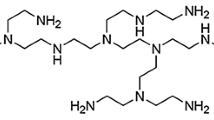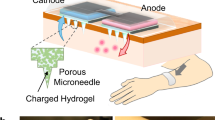Abstract
Purpose. To determine the pathways and origin of electroosmotic flow in human skin.
Methods. Iontophoretic transport of acetaminophen in full thickness human cadaver skin was visualized and quantified by scanning electrochemical microscopy. Electroosmotic flow in the shunt pathways of full thickness skin was compared to flow in the pores of excised stratum corneum and a synthetic membrane pore. The penetration of rhodamine 6G into pore structures was investigated by laser scanning confocal microscopy.
Results. Electroosmotic transport is observed in shunt pathways in full thickness human skin (e.g., hair follicles and sweat glands), but not in pore openings of freestanding stratum corneum. Absolute values of the diffusive and iontophoretic pore fluxes of acetaminophen in full thickness human skin are also reported. Rhodamine 6G is observed to penetrate to significant depths (∼200 μm) along pore pathways.
Conclusions. Iontophoresis in human cadaver skin induces localized electroosmotic flow along pore shunt paths. Electroosmotic forces arise from the passage of current through negatively charged meso- or nanoscale pores (e.g., gap functions) within cellular regions that define the pore structure beneath the stratum corneum.
Similar content being viewed by others
REFERENCES
M. J. Pikal. The role of electroosmotic flow in transdermal iontophoresis. Adv. Drug Deliv. Rev. 46:281-305 (2001).
A. Kim, P. G. Green, G. Rao, and R. H. Guy. Convective solvent flow across the skin during iontophoresis. Pharm. Res. 10:1315-1320 (1993).
D. Marro, Y. N. Kalia, M. B. Delgado-Charro, and R. H. Guy. Optimizing iontophoretic drug delivery: identification and distribution of the charge-carrying species. Pharm. Res. 18:1701-1708 (2001).
C. Curdy, Y. N. Kalia, and R. H. Guy. Post-iontophoresis recovery of human skin impedance in vivo. Eur. J. Pharm. Biopharm. 53:15-21 (2002).
C. Curdy, Y. N. Kalia, A. Naik, and R. H. Guy. Piroxicam delivery into human stratum corneum in vivo: iontophoresis versus passive diffusion. J. Control. Release 76:73-79 (2001).
S. Bose, W. R. Ravis, Y. J. Lin, L. Zhang, G. A. Hofmann, and A. K. Banga. Electrically-assisted transdermal delivery of buprienorphine. J. Control. Release 73:197-203 (2001).
S. K. Li, A. H. Ghanem, C. L. Teng, G. E. Hardee, and W. I. Higuchi. Iontophoretic transport of oligonucleotides across human epidermal membrane: a study of the Nernst-Planck model. J. Pharm. Sci. 90:915-931 (2001).
M. Kanebako, T. Inagi, and K. Takayama. Transdermal delivery of indomethacin by iontophoresis. Biol. Pharm. Bull. 25:779-782 (2002).
A. Luzardo-Alvarez, M. B. Delgado-Charro, and J. Blanco-Mendez. Iontophoretic delivery of ropinirole hydrochloride: effect of current density and vehicle formulation. Pharm. Res. 18:1714-1720 (2001).
R. M. Brand and C. Mueller. Transdermal penetration of atrazine, alachlor, and trifluralin: effect of formulation. Toxicol. Sci. 68:18-23 (2002).
M. J. Pikal and S. Shah. Transport mechanisms in iontophoresis. II. Electroosmotic flow and transference number measurements for hairless mouse skin. Pharm. Res. 7:213-221 (1990).
P. D. Grossman and J. C. Colburn. Capillary Electrophoresis. Theory and Practice, Academic Press Inc., New York, 1992
S. A. Miller, V. Y. Young, and C. R. Martin. Electroosmotic flow in template-prepared carbon nanotube membranes. J. Am. Chem. Soc. 123:12335-12342 (2001).
J. C. Giddings. Unified Separation Science, Wiley and Sons, New York, 1991.
H. Schaefer, A. Zesch, and G. Stuttgen. Skin Permeability, Springer-Verlag, New York, 1982.
E. R. Scott, H. S. White, and J. B. Phipps. Iontophoretic transport through porous membranes using scanning electrochemical microscopy: Application to in vitro studies of ion fluxes through skin. Anal. Chem. 65:1537-1545 (1993).
B. D. Bath, R. D. Lee, E. R. Scott, and H. S. White. Imaging molecular transport in porous membranes. Observation and analysis of electroosmotic flow in individual pores using the scanning electrochemical microscope. Anal. Chem. 70:1047-1058 (1998).
B. D. Bath, H. S. White, and E. R. Scott. Scanning electrochemical microscopy of iontophoretic transport in hairless mouse skin. Analysis of the relative contributions of diffusion, migration, and electroosmotic flow to transport in hair follicles. J. Pharm. Sci. 89:1537-1549 (2000).
E. R. Scott, J. B. Phipps, and H. S. White. Direct imaging of molecular transport through skin. J. Invest. Dermatol. 104:142-145 (1995).
G. Richard. Connexins: a connection with the skin. Exp. Dermatol. 9:77-96 (2000).
J. M. B. Anumonwo, S. M. Taffet, H. Gu, M. Chanson, A. P. Moreno, and M. Delmar. The carboxyl terminal domain regulates the unitary conductance and voltage dependence of connexin40 gap junction channels. Cir. Res. 88:666-673 (2001).
A. J. Bard and M. V. Mirkin. Scanning Electrochemical Microscopy, Marcel Dekker, New York, 2001.
G. L. Flynn, H. Durheim, and W. I. Higuchi. Permeation of hairless mouse skin II: membrane sectioning techniques and influence on alkanol permeabilities. J. Pharm. Sci. 70:52-56 (1981).
Y. Saito. A theoretical study on the diffusion current at the stationary electrodes of circular and narrow band types. Rev. Polarogr. 15:177-187 (1968).
N. G. Turner, L. Ferry, M. Price, C. Cullander, and R. H. Guy. Iontophoresis of Poly-L-lysines: The Role of Molecular Weight? Pharm. Res. 14:1322-1331 (1997).
H. L. Yeager. Transport Properties of Perfluorosulfonated Polymer Membranes. In H. L Yeager and A. Eisenberg (eds), Perfluorinated Ionomer Membranes, American Chemical Society, Washington DC, 1982, p. 41-64.
K. A. Mauritz, C. J. Hora, and A. J. Hopfinger. Ions in Polymers. In A. Eisenberg (ed), Advances in Chemistry Series, American Chemical Society, Washington, DC, 1980, pp. 123-144.
T. D. Gierke and W. Y. Hsu. The Cluster-Network Model of Ion Clustering in Perfluorosulfonated Membranes. In H. L. Yeager and A. Eisenberg (eds), Perfluorinated Ionomer Membranes, American Chemical Society, Washington, DC, 1982, pp. 283-307.
M. W. Verbrugge. Methanol diffusion in perfluorinated ion-exchange membranes. J. Electrochem. Soc. 136:417-423 (1989).
Author information
Authors and Affiliations
Corresponding author
Rights and permissions
About this article
Cite this article
Uitto, O.D., White, H.S. Electroosmotic Pore Transport in Human Skin. Pharm Res 20, 646–652 (2003). https://doi.org/10.1023/A:1023259102279
Issue Date:
DOI: https://doi.org/10.1023/A:1023259102279




